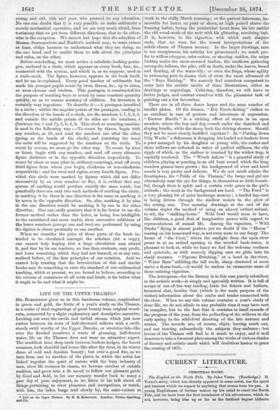LIFE ON THE UPPER THAMES.* Mn. ROBERTSON gives us in
this handsome volume, resplendent in green and gold, the fruits of a year's study on the Thames, in a series of steel engravings of great beauty from original wood- cuts, connected by a slight explanatory and descriptive narrative. Looking out over the swoln and turbid stream which just now rushes between its rows of half-drowned willows with a swift, steady swirl worthy of the Upper Danube, or stretches lake-like over the flooded meadows a waste of gleaming, half-frozen water, life on the Thames does not wear an attractive aspect. The muddiest lane, deep sunk between leafless hedges, the barest common, look cheerful and home-like after the river, in its winter dress of cold and desolate beautir ; but over a good fire, as we turn from one to another of the plates in which the artist has linked together the quiet of nature with the busy industry of man, river life resumes its charm, we become careless of outside realities, and grow into a fit mood to follow our pleasant guide by flood and field, to let our memory wander back to many a past day of pure enjoyment, as we listen to his talk about all things pertaining to river pleasures and occupations, or watch, with him, the laden barge trail slowly by, the osier-cutters at
• Life on The Upper Thaws. By H. R. Robertson. London: Virtue, Spalding, and Co. work in the chilly March morning ; or the patient fisherman, im- movable for hours on punt or shore, or high poised above the foaming lasher, luring the patriarchal trout from his lair amidst the old wood-work of the weir with his glittering, revolving bait. It is, however, to the vignettes, with which each chapter ends, that we turn for the truest interpretations of the subtle charm of Thames scenery. In the larger drawings, man is too conspicuous, his activity too pronounced ; we mach pre- fer to willow-chopper, osier-cutter, or steering maiden, the snipe lurking under the snow-covered bushes, the swallows gathering among the fellows, the pike, still as death, under the leaves, broad and floating, of the water-lily ; or even the frogs, whose agility iu swimming puts to shame that of even the most advanced of the " Boys Bathing." We scarcely feel ourselves competent to enter into the artistic merits of these illustrations, either. as dra-ivings or engravings. Criticism,- therefore, we will leave to better judges, and content ourselves with the pleasanter task of pointing out a few favourites.
There are in all three dozen larger and the same number of smaller plates. Of the former, " Boy Perch-fishing " strikes us as excellent in ease of posture and intentness of expression. "Burrow Hurdle" is a striking effect of storm in an open meadow, where the boy and dog crouch under the thatched and sloping hurdle, while the sheep back the driving shower. Should they not be more closely huddled together?. In "Putting down Grig Weels," a fisherman is dropping his loaded eel-baskets from a punt managed by his daughter or young wife, the rushes and shore willows are reflected in water of perfect stillness, the oily ripple of which, as the surface is touched by the wicker trap, is capitally rendered. The " Wreck Ashore " is a graceful study of children playing at punting in an old boat round which the long meadow grasses have grown ; the background of river and level meads is very pretty and delicate. We do not much admire the frontispiece, the "Pride of the Thames," the barge and girl are obtrusively near the eye for things, in themselves so little beauti- ful, though there is spirit and a certain rude grace in the girl's attitude ; the reeds in the background are hard. "The Ford" is a very pleasing bit of quiet landscape scenery ; a loaded hay-cart is being driven through the shallow waters in the glow of the setting sun. Two amusing drawings at the end of the volume depict the method of using an almost extinct animal, to wit, the "stalking-horse." Wild fowl would seem to have, like children, a good deal of imaginative power with regard to representations of animal life. Among the vignettes, " Wild, Ducks" flying is almost perfect, yet we doubt if the " Heron" soaring on his homeward way, is not even more to our fang. The haunt of "the Coot," where the sunlight from the open river pours in at an arched opening in the wooded back-water, is pleasant to look at, while we fancy we feel the welcome coolness and quietude, as with scarcely dipping oars we glide into its shady recesses. " Pigeons Drinking," at a bend in the river, " Water Rats" nibbling the tall reeds, sheep clustered at noon under a thorn-bush,—it would be useless to enumerate more of these enticing vignettes.
The letterpress—for the literary is in this case purely subsidiary to the artistic work—is simply and agreeably written. It is full of scraps of out-of-the-way reading, hints for fishers and bathers, botanical chat, besides that (which is the main purpose of the writer) information about the crafts and trades connected with the river. When we say this volume contains a year's study of river life, we do not allude to any probable time it may have cost its compiler, but to the fact that it contains in itself records of the progress of the year, from the pollarding of the willows in the early spring to the wild-fowl shooting of the late autumn and winter. The records are, of course, slight, leaving much out, and not treating exhaustively the subjects they embrace ; but lovers of the Thames will find in it much to enjoy, and it well deserves to take a foremost place among the works of various shades of literary and artistic merit which will doubtless hasten to greet the coming of 1875.


































 Previous page
Previous page